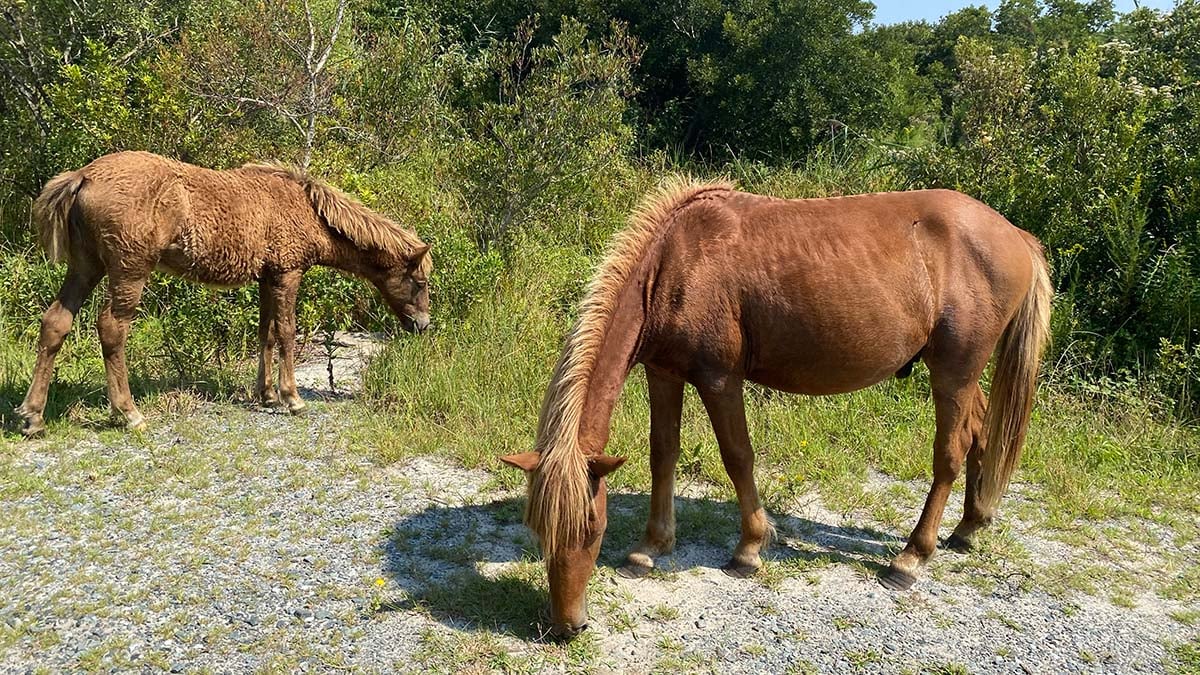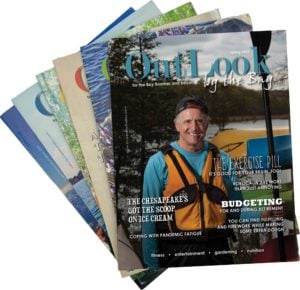Assateague Island is a 37-mile-long barrier island along the Maryland and Virginia coastline. The north 2/3 of the island is in Maryland and the south 1/3 in Virginia. On the east side of the Island is the Atlantic Ocean and on the west Sinepuxent Bay and Chincoteague Bay. The Maryland part of the island is made up of two parks — Assateague State Park and Assateague Island National Seashore. Both have campgrounds. The Virginia part of the island is the Chincoteague National Wildlife Refuge, which does not have a campground. (However, there are nearby private campgrounds.)
The Assateague State Park is at the northern end of the island in Maryland and has about 2 miles of beach. The remainder of the Island in Maryland is the Assateague Island National Seashore. Visitors can just go for a day trip or can camp in the campgrounds overnight. Both parks have beautiful ocean front beaches which provide places for walking on the beach, fishing, swimming, sunbathing, beach combing, bike riding, and observing wildlife. These parks are the only oceanfront parks in the state and as a result are very popular.
The campgrounds in the two parks have different amenities with the national park being a little more “wild.” All campsites in the state park are adjacent to the ocean side and are open and sunny, whereas the national park has sites on both the bay and ocean side with bushes and trees in some areas. The state park has electrical hook ups at some sites, but the national park does not. The state park has hot water showers and flush toilets, while the national park has cold water showers and chemical toilets. The state park is open from mid-April to the end of October, while some areas of camping in the national park are open year-round.
Assateague Island has a lot of wildlife. Being next to the ocean, there are crabs and fish, sea birds, and of course a lot of insects, particularly during the summer. The most famous animals on Assateague Island are the wild horses. There are currently about 300 wild horses who wander around the island. They are very beautiful, tough, and wild. They are also very talented at stealing food from visitors and campers. They help themselves to food on picnic tables and can even open coolers to eat the food. Visitors like to watch the horses and take pictures of them, but visitors need to keep their distance. Horses sometimes kick or bite when people get too close. Visitors are instructed to stay 40 feet away from the wild horses. The origin of the horses is not clear, but one idea is that they are descendants of survivors of a shipwreck off the coast of the island centuries ago. The National Park Service says the most plausible explanation is that they are the descendants of horses brought to Assateague in the late 17th century by owners on the mainland to avoid laws about fencing and taxation of livestock. Another interesting animal that roams Assateague Island, as well as other areas of the Eastern shore, is the Sika deer. Sika deer are tiny and are actually miniature elk that were introduced to the Eastern shore of Maryland from Eastern Asia or Japan. In the early 1920s, a small number of these Sika deer were released on Assateague Island which is their origin in the parks.
I enjoy going to Assateague Island to camp in the spring or fall. On my last camping trip to Assateague Island in October 2021, I saw many wild horses, but did not happen to see any Sika deer. One morning on that trip, I was awakened by a horse whinnying in my campsite, which was very pleasant way to wake up! My favorite experience on this last trip involved the horses. There happened to be a man camping who played the bagpipes outdoors at his campsite. One day right after he played, I walked by his campsite on the way to the beach. The bagpipe player was sitting at the picnic table, and he had three horses lined up watching him. They seemed to be waiting for more bagpipe music. That is what the bagpipe player thought too. I walked on the beach for about a half an hour and when I came back the three horses were still standing there in a row next to the picnic table waiting. In fact, they hung around his campsite for another hour or so even though he did not play anymore. I assume they must have really liked that bagpipe music.
You never know what you’re going to experience when you go camping. I have had a lot of very pleasant experiences at Assateague Island and highly recommend it to anyone interested in camping by the ocean. Be sure to go prepared and have reservations for a camp site if planning to spend the night. (During the winter, camping is first come first served in the national park).
For entrance fees and camping, the state park provides a senior discount with the Maryland golden age pass on Sunday-Thursday, while the national park provides a discount with the national golden age pass every day.
Carol Bergfeld Mills is a Professor Emerita of Goucher College and can be contacted at [email protected].
IF YOU GO
Assateague State Park
Ranger Station phone: 410-641-2918
Registration: 1-888-432-2267 or register online at parkreservations.maryland.gov
Website: https://dnr.maryland.gov/publiclands/Pages/eastern/Assateague/Camping.aspx
Assateague Island National Seashore
Ranger station phone: 410-641-1441
Reservations: 1-877-444-6777 or register online at www.recreation.gov.

Let's keep in touch!
Keep up with the latest OutLook by the Bay information by signing up here. We promise not to waste your time.


